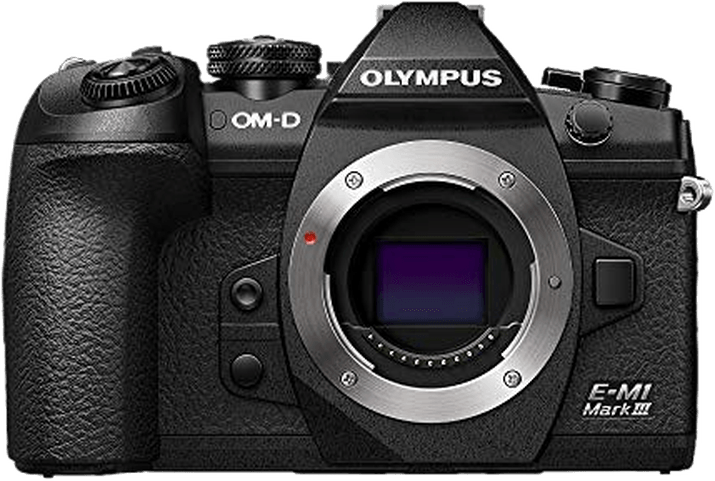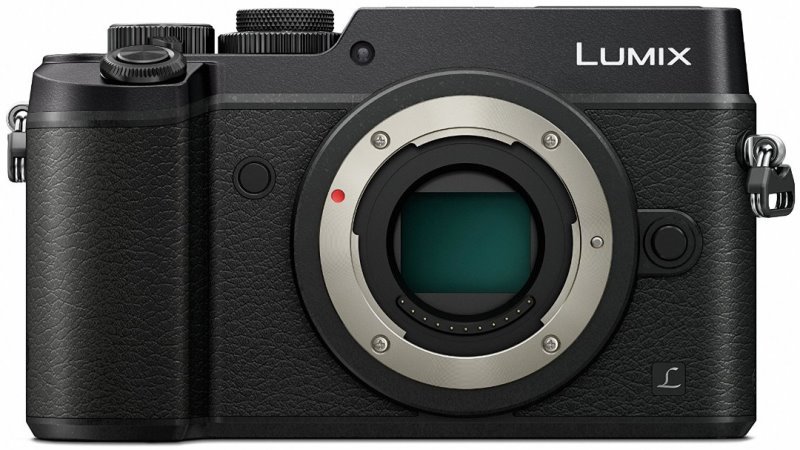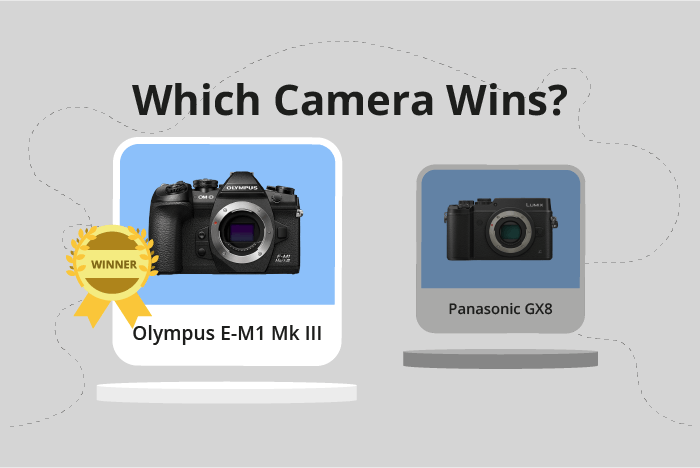Olympus OM-D E-M1 Mark III vs Panasonic Lumix DMC-GX8 Comparison
Olympus OM-D E-M1 Mark III

Panasonic Lumix DMC-GX8

The Olympus OM-D E-M1 Mark III outperforms the Panasonic Lumix DMC-GX8 with a score of 72/100 compared to 63/100. Both cameras are mirrorless and have similar dimensions: Olympus at 134 x 91 x 69mm and Panasonic at 133 x 78 x 63mm. They also share the same release price range: Olympus at $1799 and Panasonic at $1200.
The Olympus camera excels with its higher score, indicating better overall performance and features. However, the Panasonic Lumix DMC-GX8 has its advantages, such as being lighter at 487g compared to Olympus’s 580g, making it more portable.
Taking into account the scores, specifications, and prices, the Olympus OM-D E-M1 Mark III is the superior option for those seeking better performance and features. However, the Panasonic Lumix DMC-GX8 may appeal to users who prioritize a lighter and more compact camera.
Olympus OM-D E-M1 Mark III vs Panasonic Lumix DMC-GX8 Overview and Optics
The Olympus OM-D E-M1 Mark III outperforms the Panasonic Lumix DMC-GX8 in optics, scoring 68/100 compared to the GX8’s 65/100. Both cameras share several specifications, including a 20-megapixel CMOS sensor, Micro Four Thirds sensor size, Micro 4/3 lens mount, and image stabilization. However, there are key differences that contribute to their varying scores.
The E-M1 Mark III has a superior TruePic IX processor, which contributes to its faster shooting speed of 60, compared to the GX8’s Venus Engine processor and shooting speed of 10. Additionally, the E-M1 Mark III’s sensor has a higher DXOMARK score of 80, while the GX8’s sensor scores 75. These factors make the E-M1 Mark III more efficient and capable of producing higher-quality images.
On the other hand, the Panasonic Lumix DMC-GX8 has a slightly higher megapixel count of 20.3, which may offer marginally better image resolution. However, this small advantage does not outweigh the benefits provided by the E-M1 Mark III’s faster shooting speed and superior sensor performance.
Considering these points, the Olympus OM-D E-M1 Mark III proves to be the better camera in terms of optics. Its faster shooting speed and higher sensor score enable it to capture higher-quality images more efficiently. While the Panasonic Lumix DMC-GX8 has a slightly higher megapixel count, this advantage is not significant enough to make it the superior choice for optics.
Olympus OM-D E-M1 Mark III vs Panasonic Lumix DMC-GX8 Video Performance
The Olympus OM-D E-M1 Mark III outperforms the Panasonic Lumix DMC-GX8 in video capabilities with a score of 83/100 compared to the GX8’s 70/100. Both cameras share some common specifications, such as 4K max video resolution and built-in time-lapse functionality.
The E-M1 Mark III excels with higher max video dimensions at 4096 x 2160, providing a greater level of detail in video recording. Additionally, the E-M1 Mark III offers a max video frame rate of 60fps, which is more than double the GX8’s 25fps. This allows for smoother video playback and the ability to create slow-motion effects.
On the other hand, the GX8 has a slightly lower max video resolution at 3840 x 2160. While this difference may not be significant for casual users, it may matter to professionals seeking the highest possible video quality. The GX8’s max video frame rate of 25fps is also lower than the E-M1 Mark III, limiting its potential for smooth video playback and slow-motion effects.
Taking these factors into account, the Olympus OM-D E-M1 Mark III is the superior camera for video capabilities due to its higher max video dimensions and frame rate. However, the Panasonic Lumix DMC-GX8 remains a viable option for those who prioritize other features or have a lower budget. Ultimately, the choice between these two cameras depends on the user’s specific needs and preferences.
Olympus OM-D E-M1 Mark III vs Panasonic Lumix DMC-GX8 Features and Benefits
The Olympus OM-D E-M1 Mark III emerges as the winner in this comparison with a feature score of 83/100, while the Panasonic Lumix DMC-GX8 scores 70/100. Both cameras share several key specifications, including a 3-inch screen size, touchscreen capability, flip screen availability, GPS absence, and WIFI connectivity.
The Olympus OM-D E-M1 Mark III outperforms the Panasonic Lumix DMC-GX8 in various aspects. The most notable advantage is the presence of Bluetooth connectivity, which the Panasonic Lumix DMC-GX8 lacks. Bluetooth allows for seamless pairing with smartphones and other devices, enhancing the overall user experience.
On the other hand, the Panasonic Lumix DMC-GX8 has a slightly higher screen resolution at 1,040,000 dots compared to the Olympus OM-D E-M1 Mark III’s 1,037,000 dots. This higher resolution offers marginally better image clarity on the screen. However, the difference is minimal and may not significantly impact the user experience.
Considering the features, the Olympus OM-D E-M1 Mark III is the superior choice due to its higher feature score and the presence of Bluetooth connectivity. The Panasonic Lumix DMC-GX8 does have a marginally higher screen resolution but falls short in other aspects. Ultimately, potential buyers should weigh the importance of these differences based on their individual needs and preferences.
Olympus OM-D E-M1 Mark III vs Panasonic Lumix DMC-GX8 Storage and Battery
The Olympus OM-D E-M1 Mark III outperforms the Panasonic Lumix DMC-GX8 in storage and battery with a score of 71/100 compared to 21/100. Both cameras accept SD, SDHC, and SDXC memory cards. However, the Olympus E-M1 Mark III has two memory card slots, with one being UHS-II compatible, while the Panasonic GX8 has only one slot.
The Olympus E-M1 Mark III also has a longer battery life, providing 420 shots per charge using the BLH-1 battery type. In contrast, the Panasonic GX8 offers 330 shots per charge with its DMW-BLC12 battery. Additionally, the Olympus camera supports USB charging, while the Panasonic GX8 does not.
The Panasonic Lumix DMC-GX8 does not excel in any aspect of storage and battery compared to the Olympus OM-D E-M1 Mark III. The Olympus camera offers more memory card slots, UHS-II compatibility, longer battery life, and USB charging, making it a superior choice in this category.
Olympus OM-D E-M1 Mark III vs Panasonic Lumix DMC-GX8 – Our Verdict
Are you still undecided about which camera is right for you? Have a look at these popular comparisons that feature the Olympus OM-D E-M1 Mark III or the Panasonic Lumix DMC-GX8:

